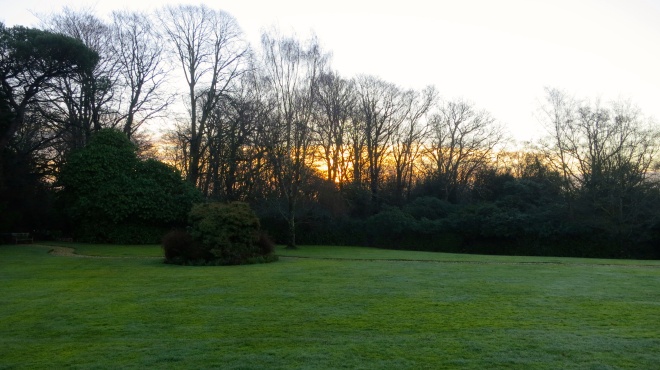

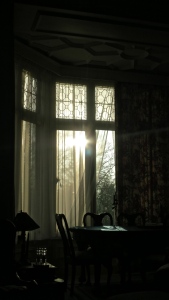
After a night of steady rain following an unrelentingly graphite-layered day on which the sun never got out of bed, it stirred itself this morning, weakly lifted its head, peeped through the trees on the Eastern side of the garden, sent exploratory fingers across the lawn, then stared through the living room windows.
Just before noon, when the sun was making its way painfully to its evening resting place on the Western corner, I wandered around the garden before we set off in the car for Clapham and Wolf’s 85th Birthday Party. 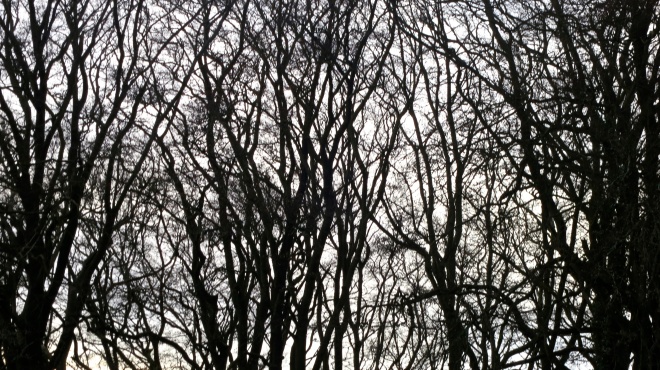 Not always managing to penetrate the cloud cover, it did manage a feeble salute for Gladstone’s sequoia.
Not always managing to penetrate the cloud cover, it did manage a feeble salute for Gladstone’s sequoia.
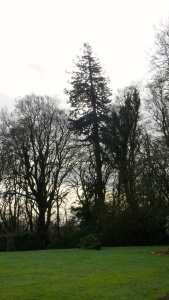
Yesterday, on the forest verge of Upper Drive I had noticed a recently exhumed skull of some forest creature. I wondered how it had found itself there, and, indeed, what it had belonged to. It is still in situ.
Our journey to Wolf And Luci’s home for the afternoon party took just over three hours, sixty five minutes of which was a slow crawl from the moment we left the A3 at Shannon Corner near Raynes Park on the A298 straight through to Clapham on the A24. We hardly ever reached above 7 miles an hour. Consequently we had the opportunity to look about us and see the changes to the landscape that is rows and rows of buildings on either side which are constantly undergoing evolution. Tooting, which had just a few Asian shops when I lived there thirty years ago is now dominated by establishments reflecting the Indian sub-continent. The Colliers Tup opposite Colliers Wood tube station has, in just over a year since we left Morden, had a complete facelift and been renamed the Charles Holden. As recently as 31st October 2012 I photographed Delhi Heights which had, before it was that fusion establishment, been an English pub. It is now Istanbul Meze Mangal, offering Mediterranean Cuisine. On the 16th of that same month The Emma Hamilton in Wimbledon Chase was no longer operating as a public house. I photographed it in its reincarnation as a car wash enterprise. It has now been pulled down and has developers’ hoardings surrounding the space it had occupied.
Tooting, which had just a few Asian shops when I lived there thirty years ago is now dominated by establishments reflecting the Indian sub-continent. The Colliers Tup opposite Colliers Wood tube station has, in just over a year since we left Morden, had a complete facelift and been renamed the Charles Holden. As recently as 31st October 2012 I photographed Delhi Heights which had, before it was that fusion establishment, been an English pub. It is now Istanbul Meze Mangal, offering Mediterranean Cuisine. On the 16th of that same month The Emma Hamilton in Wimbledon Chase was no longer operating as a public house. I photographed it in its reincarnation as a car wash enterprise. It has now been pulled down and has developers’ hoardings surrounding the space it had occupied.
Even the Nelson Hospital, where our children Matthew and Rebekah were both born, has now disappeared. One part is, the boards tell us, allocated to a McCarthy and Stone residential enterprise. The rest, retaining its facade, but otherwise demolished, bears the NHS logo on its protective barriers.
To the side of the Istanbul restaurant in the picture above can be seen the ‘black elephant’ of Colliers Wood. This is a building which is apparently unsafe either to use or demolish because it stands over the underground railway. It has, I am told, been empty for many years.
It was the ancient Greek philosopher Heraclitus who said: ‘All is flux, nothing stays still’.
Some things however, do remain constant. One of these is my forty-five year friendship with Wolf Blomfield, whose party it was today. At a small and convivial gathering Jackie and I enjoyed the company of the great man and his wife Luci, and renewed some old acquaintances, notably Wolf’s children Vishvapani and Sarah who Jackie and I knew when they were children. Grandchildren were represented by Leo and Anna. Some others there have known Wolf longer than I. One goes back seventy years.
 We were provided with a feast of tasty sandwiches, samosas, scones with jam and clotted cream, and finally chocolate birthday cake. A variety of drinks was on offer. I enjoyed some very good red wine.
We were provided with a feast of tasty sandwiches, samosas, scones with jam and clotted cream, and finally chocolate birthday cake. A variety of drinks was on offer. I enjoyed some very good red wine.
Kiti, who managed the catering, and Luci took a number of photographs. If our friend can take a hint she may e-mail some to me so that I can add one or two to this post. In the meantime, here is one Luci took of Wolf and me not so long ago.
Tag: Colliers Wood
Curry, A Biography
This morning, contemplating my lifelong relationship with curry, I took my usual route to Colliers Wood, turned right into Merton High Street, and continued to Tooting Bec Station where I boarded a tube train back to Morden.
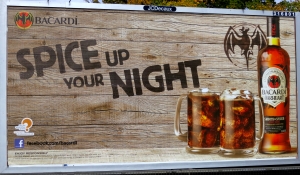 Passing a hoarding on the road which forms a bridge dividing two sections of the Wandle Trail, I reflected that, as you know, Bacardi is not the nourishment with which I would choose to spice up my night.
Passing a hoarding on the road which forms a bridge dividing two sections of the Wandle Trail, I reflected that, as you know, Bacardi is not the nourishment with which I would choose to spice up my night.
Since my previous posts are peppered with curry references, I will not point these out. There will be some repetition as I put it all together. I have written of the numerous closures of English pubs, which are often transformed into Asian restaurants.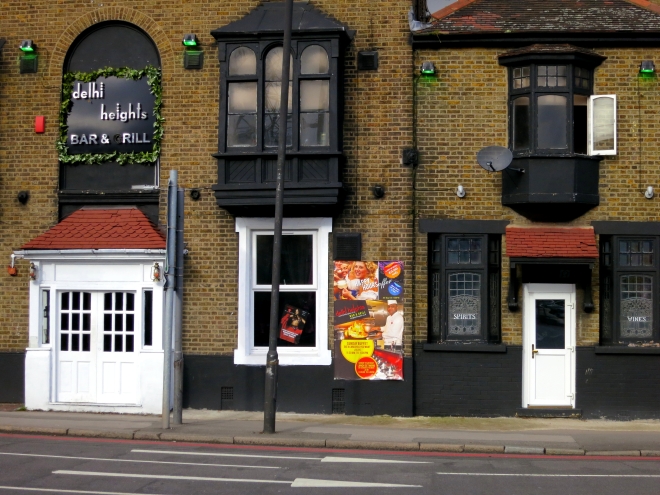 Delhi Heights in Colliers Wood manages to flourish with its fusion approach.
Delhi Heights in Colliers Wood manages to flourish with its fusion approach.
 The Sree Krishna restaurant, which I passed on the approach to Tooting Broadway, was discovered by Jessica and me during our time in Furzedown in the 1980s. We were encouraged by the fact that this South Indian establishment was frequented by indigenous doctors from the nearby St. George’s hospital. Its food remains excellent, but, good as it is, for family atmosphere and friendliness of service, it cannot match the marvellous Sri Lankan Watch Me on Morden Road. Sri Lankans were not here in the 1980s.
The Sree Krishna restaurant, which I passed on the approach to Tooting Broadway, was discovered by Jessica and me during our time in Furzedown in the 1980s. We were encouraged by the fact that this South Indian establishment was frequented by indigenous doctors from the nearby St. George’s hospital. Its food remains excellent, but, good as it is, for family atmosphere and friendliness of service, it cannot match the marvellous Sri Lankan Watch Me on Morden Road. Sri Lankans were not here in the 1980s.
The crush of crowds in Tooting Broadway rivalled Oxford Street at sales time. A young boy, bending to pick up a coin, caused a log-jam. ‘Walk properly’, cautioned his mother. ‘Nah, it’s my pound’, replied the boy, trying to avoid passers-by as he straightened up. Further on, a short man, speaking to a much taller one, was heard to utter: ‘I’ve often wished I was three inches taller, or it was three inches longer. Everyone’s got something like that’. An interesting philosophy, I thought.
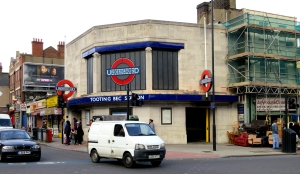 I had run past Tooting Bec station on countless occasions on my regular journey to Harrow Road in those Furzedown years.
I had run past Tooting Bec station on countless occasions on my regular journey to Harrow Road in those Furzedown years.
 Today’s title is that of Lizzie Collingham’s book which Louisa had given me and which contains the recipe for Susan’s chicken.
Today’s title is that of Lizzie Collingham’s book which Louisa had given me and which contains the recipe for Susan’s chicken.
As with so many of my life-changing directions (see post of 18th July), I have Jackie to thank for my love affair with this princess of preparations. In 1965 she introduced me to dining out, especially on her favourite food. Having married early, bought a house, and started a family, my sole experience of meals which were not home-cooked was cafe lunches funded by luncheon vouchers provided by my pre-social-work employers. When we were wed Jackie would save up the cost of a restaurant meal from her housekeeping money and we would walk up from Raynes Park to the Wimbledon Tandoori in Ridgway. During our stay in Wimbledon Village in 2011 we returned to that venue to which we introduced Becky. None of the current staff had been born in our Amity Grove years. It is now a firm favourite with Becky, and where, to the delight of those who served them, she became engaged to Ian.
The dishes of the Indian sub-continent are colourful, flavoursome, and emit a wonderful aroma. Jackie loves walking home from the Civic Centre inhaling the splendid variety of smells emanating from Morden homes. Not everyone likes the heat of chillies, but to me it is manna. It was therefore natural for me, when I began to stay overnight in my counselling room in Harrow Road, where I had my own kitchen, to learn to cook my own. This area was full of Halal shops where I could buy all the ingredients, even late at night. If the recipe called for something I didn’t have, I simply popped across the road and bought it.  The Morden Food Store has replaced those Harrow Road emporiums, and Tooting
The Morden Food Store has replaced those Harrow Road emporiums, and Tooting
Broadway now has such suppliers in abundance. 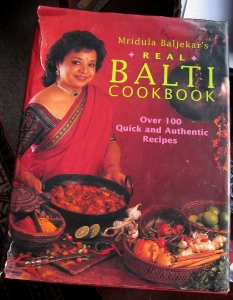 It was Jessica who bought the Balti cook book which is my curry bible, well spattered with various spices.
It was Jessica who bought the Balti cook book which is my curry bible, well spattered with various spices.
Once I grasped the basics I was able to experiment and produce my own variations. The preparation of Curried Boxing Day turkey is now a tradition in which my grandson Oliver loves to join me. Asian spices can also enhance the flavours of some traditional English dishes. Green cardomoms I find particularly beneficial in adding aromatic flavouring to stews; and garlic, not always included in our recipes, is often helpful. It was green cardomoms which upset five-year-old Oliver when I forgot to mention I had included them and he bit on one. The Italian arrabbiata makes plentiful use of chillies.
Only once have I prepared a complete meal, including the breads and complicated rice accompanying meat and vegetable dishes. I did this in Newark for our friends Jill Tattersall and Tim Cordy. I began early in the morning and it must have been 9 p.m. by the time we sat down to eat with me all in a fluster. I even made my own garlic and ginger pastes, clogging up the blender. Now I take Jackie’s advice and buy the pastes, the breads, and the samosas. ‘Why make work for yourself?’, she asks. ‘The Indian housewives don’t’. I cannot bring myself yet to use the popular sauces produced by Patak or Lloyd Grossman.
Most of what we think of as Indian restaurants are in fact Bangladeshi, almost all the staff of which originate in the Sylhet city district. I am told the influx began with sailors jumping ship in the UK. My all-time favourite is the Akash in Edgware Road, at which I have been a regular, often attending weekly, since the early 1980s. 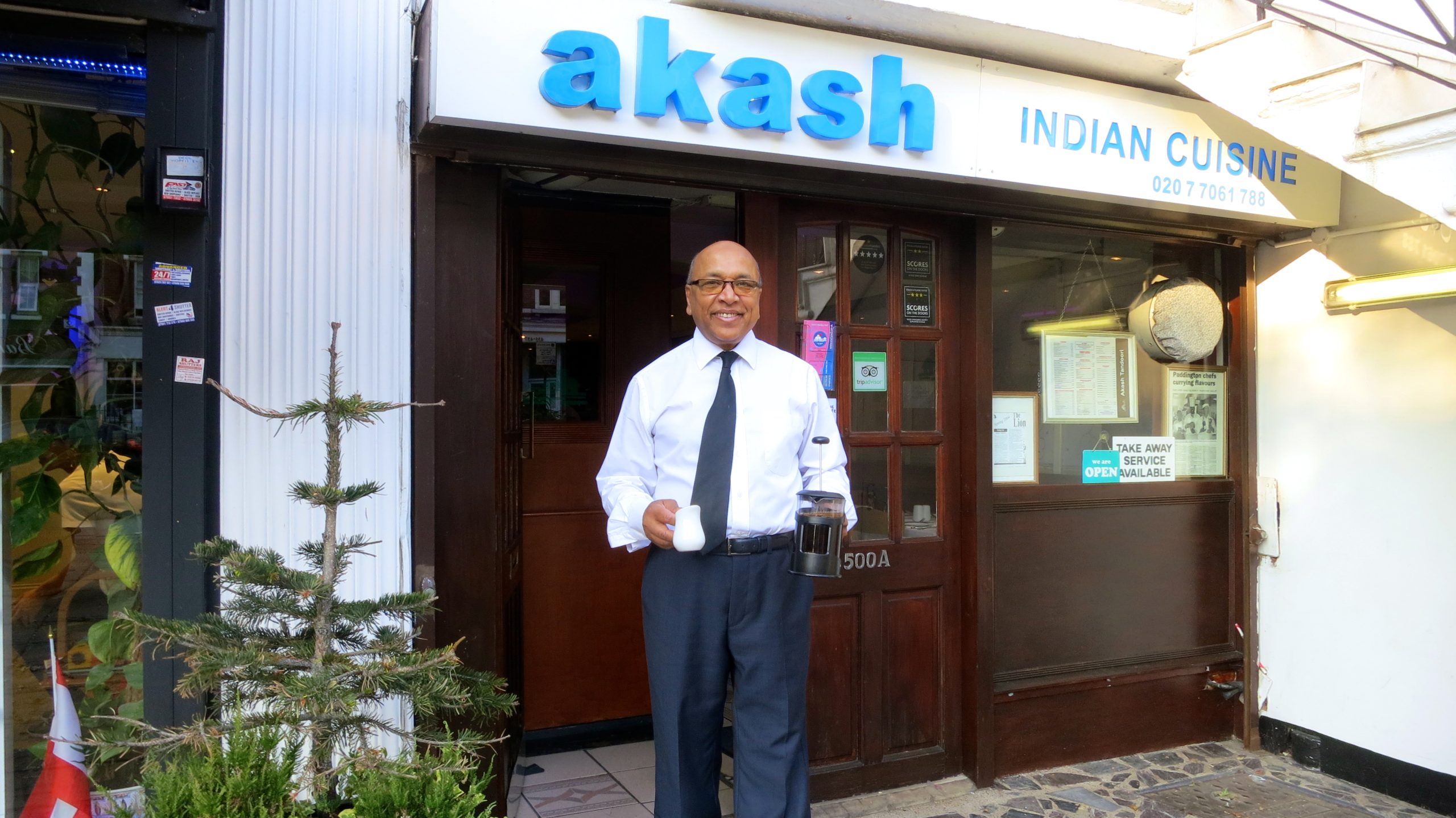 Majid, the manager, and Shafiq, the chef have been there since its opening some forty years ago. Shafiq came third in a Westminster-wide competition, beating such famous opposition as Veereswami’s in Regent Street. It must be fifteen years since I actually placed an order, for, as soon as he sees me, Shafiq begins cooking a meal they have tailor-made for me. This is a spiced-up naga strength Haldi. A Bangladeshi restaurant in Westbourne Grove, whose full title, which I cannot remember, contains Bombay, did not change it when that Indian city reverted to its name Mumbai. When I asked the proprietor why, he replied that he was not interested in an alteration. His customers would not understand.
Majid, the manager, and Shafiq, the chef have been there since its opening some forty years ago. Shafiq came third in a Westminster-wide competition, beating such famous opposition as Veereswami’s in Regent Street. It must be fifteen years since I actually placed an order, for, as soon as he sees me, Shafiq begins cooking a meal they have tailor-made for me. This is a spiced-up naga strength Haldi. A Bangladeshi restaurant in Westbourne Grove, whose full title, which I cannot remember, contains Bombay, did not change it when that Indian city reverted to its name Mumbai. When I asked the proprietor why, he replied that he was not interested in an alteration. His customers would not understand.
Veereswami’s was the first Indian restaurant in London, having been established for the benefit of officers of the Raj on leave in their home country, yet missing the culinary delights of their adopted one. It now has a modern ambience and decor, with trendy design and staffed by waiters and managers in fashionable dress. Others who have rejected the traditional famous flock wallpaper are the Tandoori in Woolston in Hampshire, and the Shaan in Churchgate, Newark. These latter two are notable for their modern artwork and the Shaan, in particular, for the vibrant washes on its walls. The Shaan is unique in my experience in that white English waiting staff outnumber those from Bangladesh. The owner was born and brought up in Newark although he still employs native immigrants. His family run another, long established, restaurant, which survives, in my view, on reputation alone.
With certain exceptions, such as some, but by no means all, in the West End of London, these Asian restaurants present excellent value for money. Service is usually attentive, professional, and comfortable, offering napkins and finger wipes, with mints accompanying the bill. This does not apply to Mitcham’s Raj, although if you can wait several hours; bring your own napkins; ask for a drink for which the waiter can dash out to the next-door shop; try not to tear the soiled paper tablecloths; and help yourself to cutlery; you will find the food exemplary. Like Eastern Nights in Thornhill, they are dependent on takeaway meals for survival. The Akash, also has a steady takeaway trade which keeps one dedicated member of staff rushing in and out all night. This method of obtaining an evening meal has its place, for example if you have young children in bed asleep, or, as once in my case, you are suffering from a fever which only an Akash special can assuage. I prefer to sit down and be served dishes which have come straight from the kitchen.
And let us not forget that Chicken Tikka Masala has now overtaken fish and chips or roast beef as the English national dish. This has been specially adapted for us because we like our gravy.
This evening we collected our friend Sheila from her home in Tooting to eat in the Sree Krishna. It being Hallowe’en they had candlelit pumpkins on the bar, which reminded me that Majeed at the Akash always erects a Christmas Tree. Sheila drank sparkling water whilst Jackie and I had Kingfisher. The meal was first rate and the coffee was particularly good.
The Deen City Farm
This morning having been the one for bin collection, the foxes had created their usual mayhem on the lawn. I do wish our neighbours would double-wrap or rinse their waste food products. Before I could get to the rubbish someone had again cleared it up. Was it our helpful stranger and her toddler assistant? Or perhaps helpful fairies?
I spent some little time revising a couple of clues for next week’s Independent cryptic crossword, and so went out later than usual for my walk. I met Jackie coming to pick up the car for a visit to a client. Again an encounter with her determined the direction of my walk. She was going to the Phipp’s Bridge Estate in Mitcham. I therefore travelled with her there and she dropped me on that side of Morden Hall Park so I could walk from there. I took the path onto the Wandle trail and soon realised that I was close to the Deen City Farm which is situated alongside the trail. I had often noticed the farm on my trips to Colliers Wood. Today I decided to visit it. It is a charitable community project and a godsend to the residents of Mitcham’s estates and beyond.
Passing the magnificent chickens and flamboyant turkeys, the visitor encounters preening waterfowl and sprawling rabbits, all huge specimens. There are sheep, goats, llamas, cattle and horses. Indeed, the farm also has a riding school. The community garden is well stocked with flowers and a number of vegetables.
Those children there today were all pre-school and mostly accompanied by their mothers who had walked the same path from Phipp’s Bridge. There is an ample car park for those who come from further afield.
There are a number of these community projects in our cities, ensuring that children who otherwise would have no experience of country life have the opportunity to gain such pleasure. Some of my own grandchildren, who do eat well from natural produce and do visit the countryside, were once amazed to see me shelling peas. They had never had any but frozen ones. Not that there is anything wrong with Bird’s Eye, which are often fresher than those that have been in the shops or on the market stalls for a while.
Louisa and Errol, near their home in Nottingham, have the White Posts Farm, to which Jessica and I took her and Sam when they were little; and Malachi had his third birthday party in the city farm in Hackney.
I made a beef curry this evening. This went down well, especially accompanied by Cobra beer.
Contrasts
Coffee this morning with a friend in SW1, followed by lunch with another in NW10. I began with a walk to Colliers Wood, mostly through Morden Hall (National Trust) Park and Merton’s Wandle Trail. The boundary between the two is a modern tramline. The Wandle is one of London’s lost rivers; the trail being a stretch of wooded land alongside the water.
Most of the people in the congested High Street running through South London past Colliers Wood and on through Clapham must be oblivious of this pleasant walk. I suffered such oblivion when, as a teenager in the 1950s I regularly walked from Raynes Park to Tooting to visit an art-house cinema. I had the 1/9d for admission, but not the extra few pence for bus fares. Kevin Lydon, a schoolmate, thought this was pretentious. When I think of how many unintelligible subtitled black and white films I sat through I’m sure he was probably right.
From Colliers Wood I travelled on the tube to Victoria and on to my friend’s flat in Rochester Row. After coffee it was off to Harlesden for lunch.
Turning right out of Neasden tube station the contrast between the High Street there and Victoria Street, SW1 was marked. The wind gusting up the hill on a less rain sodden day would have carried blinding and irritating dust from the commercial recycling depot at the bottom of the hill. The pavements were so uneven as to be bearing pools of water which it was difficult to avoid. The older, smaller, St. Mary’s Church with its graveyard seemed a world apart from Westminster Cathedral; and The Burren in Roundwood Road, a friendly Irish pub, humble in comparison with the grand Victorian pubs, such as the Windsor Castle in Francis Street, which are to be found in Victoria.
Victoria’s buildings are mostly enormous; commercial ones usually modern and with walls of glass, residential ones usually older stylish and elegant blocks of flats. It’s all rather grand and overbearing. The only large modern building in this part of NW10 is the Magistrate’s Court. There are blocks of less opulent looking flats, but most dwellings are terraces of small family homes, the older, larger ones often converted into two flats.
Victoria Street is well populated by modern shops, including a large department store, and City Hall itself. Church Road, the local shopping centre for my friend Norman, is full of small shops which have seen better days and which are constantly changing hands. Many of these latter shops are run by immigrants, the latest of whom are from Somalia. The Road has a strong sense of community and the shops are stacked with produce attractive to those who live there.
As a schoolboy I had to walk because I didn’t have the busfare. As a pensioner I only walk when I want to. Thanks to the Freedom Pass I am able to travel free and freely using any form of transport in the 6 London Transport zones. This includes overland railways. It is a marvellous facility which really lives up to its name.